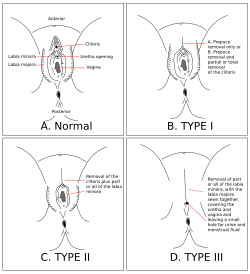There are no health benefits associated with FGM. The severity of the medical risks varies according to the extent of the cutting. In a 2013 study of 558 girls and women aged 12–47, 31.7% had type Ib; 64.1%, type IIb; and 4.2%, type IIc (4 participants refused the exam). [5] Short-term effects of FGM include excessive bleeding, local infections, and incomplete healing. Long-term effects include scarring, genital ulcers, dermoid inclusion cysts, lower abdominal pain, and infertility. But the worst effect is death at delivery, the rate of which is excessively high in Sierra Leone [5]
Female Genital Mutilation Impact on Health
Sierra Leone is one out of twenty-eight African countries that practices Female Genital Mutilation. Almost 90% of Sierra Leonean women will undergo FGM. Most often the operation involves the use of blunt instruments such as razor blades, penknives, or broken glass. [15]
Many women that have experienced FGM reported having severe pain, shock caused by pain, excessive bleeding (haemorrhage), swelling that makes it difficult to pass urine and feces, infections, and oedema. [16] A study in Sierra Leone concluded that women who underwent FGM experienced excessive bleeding, tenderness, inability to heal well, difficulty when urinating, and infections such as Urinary Tract Infections (UTI's). [17]
Female genital mutilation is followed by both short-term and long-term effects. Immediate signs of complications appear within a few hours and can last up to ten days after the procedure. Long-term problems were present more than ten days later and were associated with pregnancy affectations during labor and/or childbirth. [18]
The most common short-term health complications involve hemorrhaging that can result in shock or death. Infection to the entire pelvic organs can occur which can lead to sepsis. Tetanus and gangrene can lead to death. Intense pain that causes shock during and after procedure. The use of blunt instruments can damage the adjoining organs. Lastly, urine retention occurs from swelling and/or blockage of the urethra. [19]
Long-term health consequences associated with FGM include dermoid cysts and abscesses, chronic pelvic infections that can lead to chronic back and pelvic pain as well as urinary tract infections. [20]
Other long-term complications involve painful and blocked menses (menstrual dysfunction) that can result in
- hematocolpos - accumulation of menstrual blood in the vagina,
- hematometra - accumulation of menstrual blood in the uterus, and
- hematosalpinx - accumulation of menstrual blood in the fallopian tubes
In addition, sexual problems are more prevalent among women with FGM. Women with FGM reported having persistent pain during sexual intercourse. Furthermore, the penis may become obstructed from penetrating the vagina which can require a surgical procedure. And, sexual dysfunction such as the inability to attain an orgasm during copulation is also common. [19]
Moreover, there is an increased risk of maternal and child morbidity due to obstructed labor. A recent study found higher death rates (including stillbirths) among infants born to mothers who have experienced FGM than mothers with no FGM. Women with Type I FGM were at 15% more likely, Type II women had a 32% increase, and Type III women had an overall 55% chance of experiencing death or stillbirth. [21]
Chronic urinary tract infections, incontinentia urine (inability to control urination), infertility, abscesses, dermoid cysts, keloid scars (hardening of the scars) and increase risks to HIV infection are also associated with long-term health complications of FGM. [19]
FGM can also result in psychological trauma. Notably, post-traumatic stress disorder, anxiety, depression, and psychosexual problems. Studies demonstrate that women with FGM are more likely to encounter psychological disturbances such as low self-esteem, somatization, and phobia. [22]


